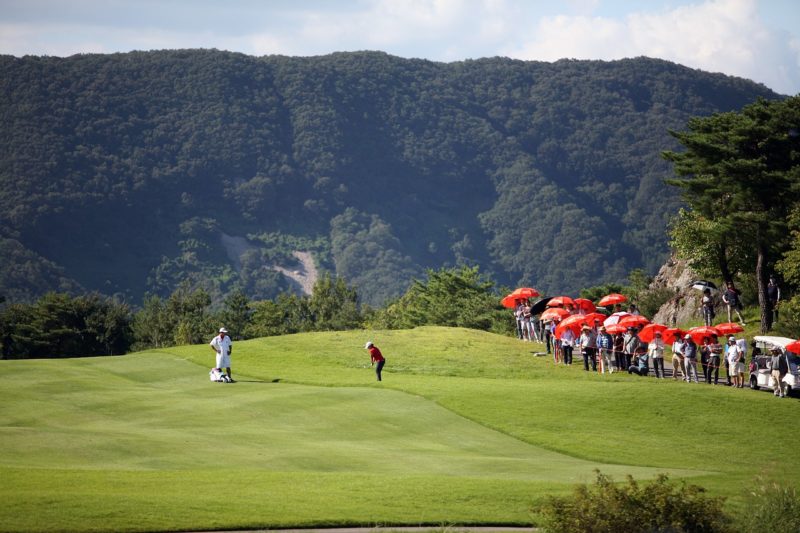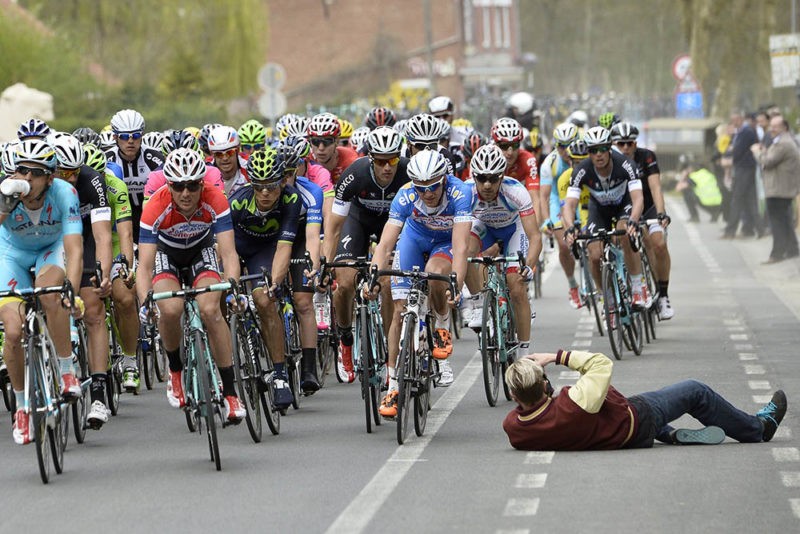Golf fans around the world will have been glued to their televisions last weekend for the biennial festival of golf that is the Ryder Cup, which made the headlines when a spectator was seriously hurt by a golf ball. If you’re running a sporting or music event, whose responsibility is it to make sure the crowd is safe from the action?

Spectator safety made mainstream news following the Ryder Cup at Le Golf National in Paris, as a wayward tee shot from American player Brooks Koepka struck a fan, 49-year-old Corine Remande, on the head.
This is not a rare occurrence at golf tournaments, where crowds are often close to the action and modern technology is now seeing drives fly well in excess of 300 yards, with an average ball speed of 167.10 miles per hour.
The BBC reported that there are an average 12,400 golf-related injuries which require hospital treatment each year in the UK alone, according to specialist insurance company Golf Care.
As is typical in this situation, Koepka approached the stricken fan, who was receiving medical attention at the time, gave her a signed golf glove and went on with his round.
The story became more serious in the days after the event when it was announced that Ms Remande has lost the sight in her right eye as a result of the incident and is threatening legal action against the organisers.
She said: “It happened so fast, I didn’t feel any pain when I was hit.
“I didn’t feel like the ball had struck my eye and then I felt the blood start to pour. The scan on Friday confirmed a fracture of the right eye-socket and an explosion of the eyeball.”
Amateur golfers are well-versed in the practise of shouting ‘fore’ when they hit an errant shot, to warn others on the course of any impending danger.
In the professional game though, this is not such a common occurrence – despite the vastly increased numbers of people potentially ‘in harm’s way’.
Whether that’s because the pros are so unused to hitting the ball anywhere other than the middle of the fairway, or whether they are over-reliant on marshals signalling from the tee as to which direction the ball is heading, is hard to tell.
Who is responsible?
So, who is responsible if a spectator gets hit? The organisers? The marshals? The players? The spectators themselves?
Should the fans be standing further back?
I touched on driving distance earlier, and perhaps a rethink is due. For example, in 1997, American John Daly became the first golfer on the PGA Tour to average more than 300 yards per drive. That year, he was more than 30 yards longer than the average tour player. Now, 21 years later, the entire tour averages 295.3 yards.
When you are over 300 yards away, often not even being able to see the tee itself, it can be hard to hear a shout of ‘fore’ in a bustling crowd or see a signal from a marshal. Ms Remande claims that neither happened, something which was disputed by the organisers.
She also alleged that there was a lack of safety warnings on the ticket and signage around the venue.
I think it’s important to note the nature of the event. Golfers and keen golf fans will understand the protocol, but the Ryder Cup is an event with transcends golf and attracts ‘casual’ fans. Do the organisers do enough to warn these people of the dangers?
Andrew McQuillan, Crowd Safety Management Consultant, told SHP: “Having worked on European Tour events managing safety, the only circumstances I could see for liability for the organiser here is if the rope lines are deemed to have been badly placed (i.e. there was a very high risk of balls falling there).
“The people who mark out rope areas are somewhat separate from safety teams and sometimes there are competing demands between course layout and safety. There are also ticketing terms which fans consent too at point of purchase to remove liability for such incidents.”
General risk
Point 20 in the event’s terms and conditions reads: ‘Persons entering the Venue do so acknowledging the general risk associated with the game of golf and attending a major golf tournament, including risks associated with errant golf shots and the attendance of large crowds in confined spaces to watch limited gold holes (and surges of spectators accordingly).’
Mark Breen, crowd safety expert and Director at Safe Events, agrees: “In general terms, I think that there has to be more weight afforded to personal responsibility in situations like these. For me, it’s reasonable to expect golf balls may end up in the crowd. Therefore, if I choose to be in that crowd, I’ve accepted that there’s a risk I could be hit by a golf ball.
“That said, there is, of course, a duty of care on the organisers, as well as the player I believe, to give reasonable warning if the ball looks like it’s heading for the crowd.
“The interesting question for me lies around the Ryder Cup organisers’ procedures. If there are procedures whereby, for instance, on-course marshals raise a sign and shout to warn spectators a ball may be coming towards them, then it becomes a question of whether the system was implemented here.
“For me it’s about what’s reasonable. I think it’s reasonable for a spectator to understand they may be hit by a ball. I think it’s reasonable to expect the organisers have an established system to warn of wayward balls too.
“Sometimes accidents happen and it’s not necessarily somebody’s fault through negligence. That’s what insurance is there for.
Irish professional golfer, Shane Lowry, has been pretty vocal in the past on the lack of shouts from his fellow professionals.
Jamie Fewster, Head of Production Safety, 1st Option Safety, said that organisers can’t just dismiss things as ‘unforeseen circumstances’: “Even though accidents such as this may be out of the organisers control, they can still be reasonably foreseen, and while people attending such events accept a level of risk in doing so, the organisers still have a duty to do everything that is reasonably practical to keep people safe.
“Any legal action in these sorts of cases will usually revolve around whether the accident could be reasonably foreseen and whether adequate safeguards were in place. The event organisers have a duty of care to members of the public.”
Unforeseen incidents
What about other sports, how do they mitigate against ‘unforeseen incidents’?
Perhaps the toughest events to secure and maintain public safety, are those that are not restricted to a confined space. Some motorsports, cycling events, triathlons, marathons and fun runs can be spread across sometimes hundreds of kilometres of public roads, making it a real challenge to keep participants and spectators safe.
Ben Taylor, Managing Director of Dayinsure Wales Rally GB, Britain’s round of the FIA World Rally Championship, told SHP how he relies on the expertise of trained members of the public and an educated audience.
He said that rallying has progressed a great deal in recent years, from being a sport where spectators could roam almost wherever they like, often choosing to put themselves far too close to speeding cars to try and get the perfect photo, or just for a thrill. Now, months of planning goes into providing safe, dedicated viewing areas for fans. He added that the sport’s governing body, the FIA, can cancel competitive stages if it believes spectators are being allowed to stand in dangerous places.
“We have an event taking place in public locations, such as forests across, half a country. As a result, we rely on the expertise of 2,000 highly trained volunteer marshals, the goodwill and education of the spectators and the skills of the event organising team to plan the competitive stages in such a way that we ensure, as far as possible, that spectators are in locations that don’t present themselves, or other people, in danger.”
Fans taking photos, a problem exacerbated by phone cameras, are also an increasing problem at events like these. Fans often turn their back on the action to take a ‘selfie’, invariably putting themselves in danger.
Last week, the BBC reported that 259 people have been killed taking selfies between 2011 and 2017.

A fan takes a photo in front of the peloton in the 2014 Ghent-Wevelgem. Photo courtesy of Cycling Weekly Magazine.
Safety precautions
On the same weekend as the incident at the Ryder Cup, Coventry City goalkeeper Lee Burge was hit on the head by a puck, watching local ice hockey team, Coventry Blaze.
In 2002, a spectator in America died as a result of being hit by a puck in an NHL game, prompting the league to take new precautions around fan safety. At most ice hockey games in the states, fans will be warned on tickets, signs and the scoreboard of the dangers of flying pucks. Following the incident, all NHL teams were required to install 18-foot mesh nets behind the goals, designed to catch pucks that fly above the standard eight-foot glass barrier.
Football fans don’t have the same protection. Being stuck by a ball while the players are warming up is a particularly common occurrence, as fans may be making their way into the stadium and are not watching what is happening on the field. SHP spoke to Sarah Green, Head of Health & Safety at Aston Villa Football Club, to see what precautions are in place to combat this.
“It shouldn’t be a surprise to you that at AVFC, crowd safety is of paramount importance to us. This sometimes can be a challenge with the potential for 43,000 fans arriving at the Stadium on a match day.
“This season as part of the new pitch renovation project, we introduced a crowd protection ball stop system for use during the warm-ups at both ends of the Stadium. In previous seasons we have had instances of fans being hit by balls pre-match, usually resulting in minor injuries. The introduction of the netting has resulted in no reported incidents so far this season.

“The serious injury at the Ryder Cup raises questions for any safety professional seeking proportionate and practical solutions to risks present at any sporting event. Public safety is of course the priority and it’s an interesting debate to identify lines of responsibility and what is reasonable to prevent what are now foreseeable accidents whilst not affecting the enjoyment, public participation and the atmosphere at any event.”
In Baseball, it’s not just the ball which can cause injury – with hitter’s often hurling the bat after they have hit the ball. According to the book by Robert M. Gorman and David Weeks, Death at the Ballpark, 61 spectators had been killed up to 2007 from being hit by balls or bats (though most of these deaths occurred at amateur games), and 15 had died from falling from the stands.
Music events
Flying objects, and people, also cause concern for organisers of music events, according to Safety Advisor Matt Stone, from AD Health & Safety, who spoke to SHP about artists throwing instruments, and sometimes themselves, into the audience.
“Spontaneous artist activity is never welcome as it has the potential to cause audience reactions. In such circumstances from a liability perspective it would ultimately be the artist and their management who would carry the responsibility.
“There is nothing worse from a safety perspective to hear an artist encouraging an audience onto a stage or going on an unscheduled walk through the audience. Fortunately, these days spontaneous instances are rare occurrences.
“More often than not there is a degree of planning to safely choreograph treads from the front of the stage into the pit area or even a graduated decking system to safely allow an audience invade a stage. Security staff would either accompany the artist or be strategically positioned to come to their aid if they have issues within the audience.”
He continued: “Event organisers have the primary responsibility to ensure that there are appropriate measures and resources in place to deal with all reasonably foreseen scenarios and proportionate to the threat however, members of the public, to a degree, have a duty of care for themselves and others and should not be putting themselves into potentially dangerous situations or exacerbating a situation. Additionally they should go to events or crowded spaces with a ‘see something say something’ attitude.”
The Safety Conversation Podcast: Listen now!
The Safety Conversation with SHP (previously the Safety and Health Podcast) aims to bring you the latest news, insights and legislation updates in the form of interviews, discussions and panel debates from leading figures within the profession.
Find us on Apple Podcasts, Spotify and Google Podcasts, subscribe and join the conversation today!





Thanks some interesting points, although I note that alcohol at events is notable by its absence in the article. By making alcohol widely available at certain events whilst usually enhancing the experience ca also have an unwanted detrimental effect leading to erratic behaviours.
Very much agree Simon, this all adds in to the point about ‘casual’ fans at events like the Ryder Cup. Fans who are there for the spectacle and to have a good time, the event itself being a secondary thought, which could increase their personal risk.
I’m a H&S Professional and a golfer. I feel for the golfer and the tournament organisers. To me it was clear when the drive was hit it was not going to hit the fairway – (I watched the TV all weekend) – The golfer clearly raised his arm and his club in the direction of the flight of the ball – standard practice where you believe ‘fore’ cannot be heard. You know where you are standing, you can see the yardage of a hole and you can work out approximate yardages based on the 150 yard markers etc, so you… Read more »
So Aston Villa have introduced a crowd protection ball stop system…would that be a net?
And people wonder why health and safety get a bad name…